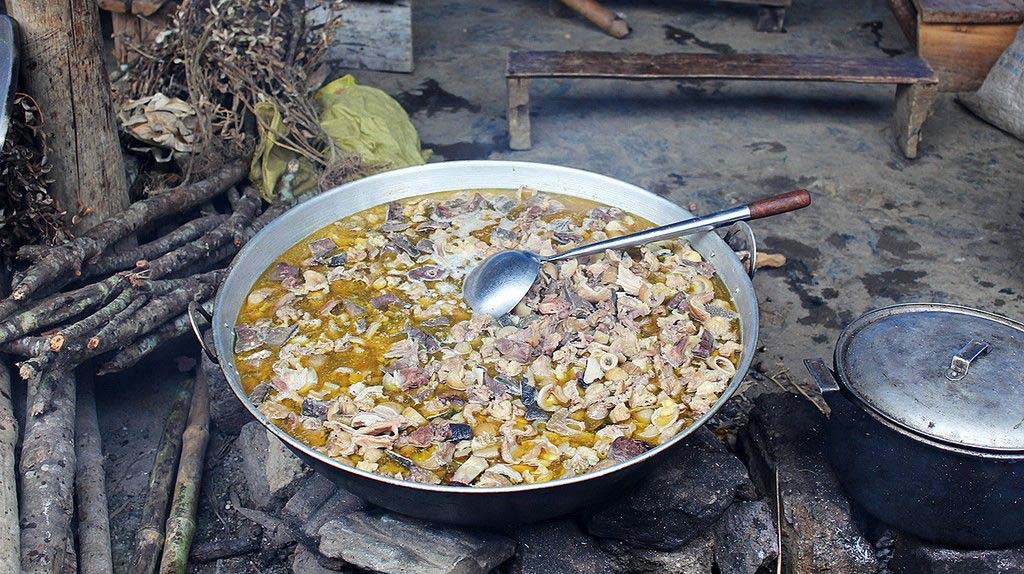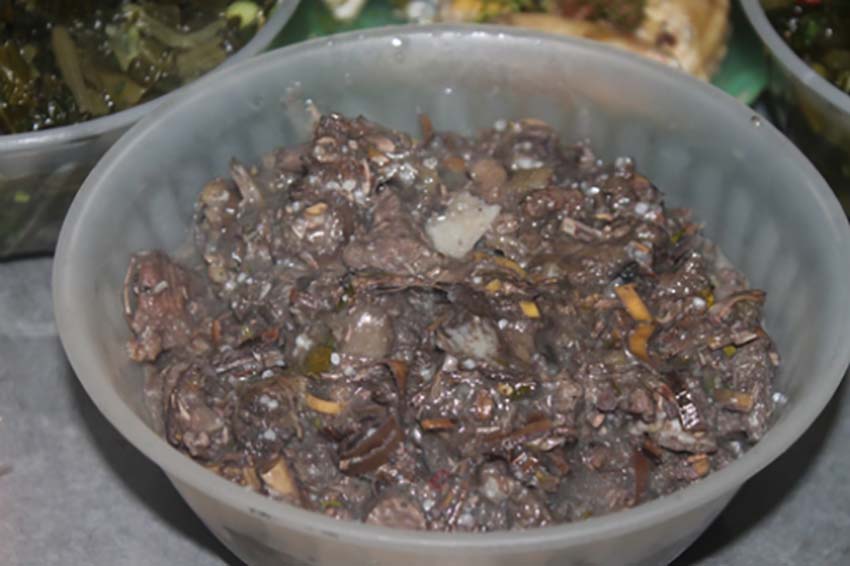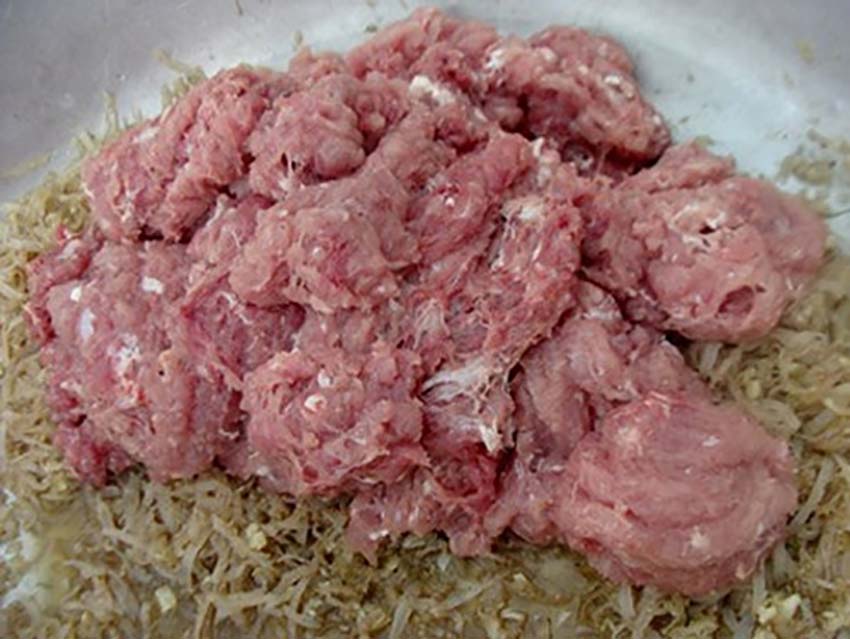Tourists who are stunned with the dishes are scared to hear the name, smell the haunted smell
Vietnamese cuisine: Nam Pia
You probably wouldn’t imagine eating animal feces with this bizarre specialty in the Northwest. Only travelers with audacity and a spirit of steel dare to “enjoy” this dish.
Nam pia, also known as nam pia, is a traditional dish of the Thai people. “Nam” or “Nam” in Thai means soup, and “pia” refers to the viscous mucus that sticks to the small intestine of herbivores. It is the digestive juices and incompletely digested food of these animals, so many people call this strange dish young manure soup.

Northwest dishes challenge the taste (Photo: PasGo)
This dish can be considered as a “delicious delicacy” when it is only processed and served during festivals or when welcoming guests. This unique dish is marinated with Northwestern spices and flavors such as mac Khen seeds, honey, bitter leaves, etc.
This unique culture will surely be an interesting experience for foodies brave enough to taste.
Vietnamese cuisine: Thang Co
Thang Co (or Month Co) is a typical traditional dish of the H’mong people. It is said that the name of this dish in the Sino-Vietnamese sense means thang co, ie bone soup. This unique dish is made from simmered horse bones, buffalo bones and internal organs. In order to achieve the typical taste of the Mong people, it seems that only the Mong people are able to process this dish properly with many years of accumulation from the family secret.

The dish can “cause nostalgia” for tourists to Lao Cai (Photo: Foody)
The most impressive dish is Thang Co horse with the main ingredient being the muscle and lean meat of the horse after being slaughtered and filtered. The bones are cut into small pieces, the tendons, fat and shredded meat are filtered and cut into small pieces along with the heart, liver, and lungs.
Those are the ingredients that make up the soul of the dish. The processing hand of the people here is the key to making the unforgettable taste of the ancient dish. Must be very skillful, skillful in the simmering time, taste the correct seasoning so that the dish does not taste too salty or still retain the bad smell of the internal organs.
Surely this will be a new and memorable experience for visitors who have the opportunity to taste this specialty with the strong smell of Northwest smoke. Once you’ve indulged in this flavor, you may wish to taste it again, but if you can’t “swallow” it, it’s sure to be a horrifying dining experience that you won’t want to try again.
Vietnamese cuisine: Rotten meat cooked with vegetables
Dubbed the four greats “the most rotten, the most rotten, the three horrible, the four hideous” of Son La specialties, the dish of rotten meat cooked with vegetables will make any visitor stunned when they see and taste it with their own eyes. “shivering” taste of this unique specialty.
This specialty is both curious and terrifying to tourists coming to Son La by a question as to why a dish made from these hideous ingredients has such a great attraction?

Horror food, but the more you eat it, the more addictive it becomes (Photo: Timeout Vietnam)
For the Kho Mu people, the more rotten the meat, the more qualified it will be because it will bring a special and unforgettable taste. To create this dish, they will hang the most easily rotten parts such as organs in the kitchen upstairs for a week and then sprinkle water daily. A flesh full of flies and maggots after being decomposed to the point of stink is the result of this process.
In particular, this concentrated flavor is also doubled by the rotten meat dish that, after drying in the kitchen, will be cooked with a typical rotten vegetable that grows wild in the forests.
Vietnamese cuisine: Raw pork spring rolls
Vi Thuy village, Thai Binh is stunned by the custom of eating raw meat. Raw pork roll is a traditional dish representing the village. Nem chao is made from raw meat and is eaten fresh and raw. It is still a familiar and popular spring rolls, but in Vi Thuy village, people eat raw marinated pork.

The village where people have the custom of eating raw meat (Photo: BT)
Those who hear the name of this dish for the first time will surely find it a bit scary when they see a plate of red raw meat arranged round on the plate. The people here are proud to mention this long-standing traditional dish not only because of its uniqueness but also by the skillful processing of the villagers of Vi Thuy. It takes many years of experience to be able to reduce and balance the processing time so that people do not have stomach pain and need to go through quite sophisticated and time consuming stages of preparation and processing. The sweet and fleshy taste of raw meat, the fat of the fat and the chewiness of the skin mixed with special spices create an unforgettable flavor for this raw meat spring rolls.
Vietnamese cuisine: Dried imitations
Dried imitation, or people call it “Long-legged dancer” is a familiar dish with Westerners and drinking people. The interesting name of the dried imitation is explained by the fun shape of the dish, which is compared to the frogs lying down. Among the unique local specialties, it seems that dried imitation is one of the easiest and most addictive dishes.

“Long-legged dancer” – Impressive specialties in the West (Photo: Western specialties)
Mixing this dish with a little beer is definitely a must-try experience for foodies. The dried imitation is deep-fried, dipped with a little bit of typical tamarind sauce
stimulate the taste buds of tourists. Spicy, the, sour, sweet, and salty flavors blend to create an impressive characteristic flavor of dried imitation.
Preliminary processing, deodorizing, seasoning and drying are the basic steps to make delicious specialties to sip and enjoy.
at Blogtuan.info – Source: danviet.vn – Read the original article here



